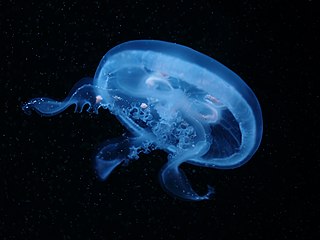
Aurelia aurita is a species of the genus Aurelia. All species in the genus are very similar, and it is difficult to identify Aurelia medusae without genetic sampling; most of what follows applies equally to all species of the genus.

Cassiopea is a genus of true jellyfish and the only members of the family Cassiopeidae. They are found in warmer coastal regions around the world, including shallow mangrove swamps, mudflats, canals, and turtle grass flats in Florida, and the Caribbean and Micronesia. The medusa usually lives upside-down on the bottom, which has earned them the common name. These jellyfish partake in a symbiotic relationship with photosynthetic dinoflagellates and therefore, must lie upside-down in areas with sufficient light penetration to fuel their energy source. Where found, there may be numerous individuals with varying shades of white, blue, green and brown.

Aurelia is a genus of scyphozoan jellyfish, commonly called moon jellies. There are currently 25 accepted species and many that are still not formally described.
A species description is a formal scientific description of a newly encountered species, usually in the form of a scientific paper. Its purpose is to give a clear description of a new species of organism and explain how it differs from species that have been described previously or are related. To be considered valid, a species description must follow guidelines established over time. Naming requires adherence to respective codes, for example: in zoology, the International Code of Zoological Nomenclature (ICZN); plants, the International Code of Nomenclature for algae, fungi, and plants (ICN); viruses, the International Committee on Taxonomy of Viruses (ICTV). The species description often contains photographs or other illustrations of type material along with a note on where they are deposited. The publication in which the species is described gives the new species a formal scientific name. Some 1.9 million species have been identified and described, out of some 8.7 million that may actually exist. Millions more have become extinct throughout the existence of life on Earth.

Aurelia labiata is a species of moon jellyfish. It is a cnidarian in the family Ulmaridae. It is typically larger than Aurelia aurita, with individuals document up to 45 cm (18 in). However, much of its size range overlaps with A. aurita, making size an imperfect diagnostic tool. Most Aurelia labiata have a 16-scalloped bell, meaning the bell indents inward at 16 points, a characteristic that also appears in other Aurelia species. Aurelia labiata occurs in the northeastern Pacific Ocean, from the northern coast of California, north to Canada and into Alaska.

Diadumene is a genus of sea anemones. It is the only genus in the monotypic family Diadumenidae.

Cassiopea ornata are one of many Cnidarian species called the upside-down jellyfish. This pelagic jellyfish primarily lives in tropical waters, off the coast of Australia in shallow lagoons and around mangrove trees. The name "upside-down jellyfish" comes from the fact that it appears to be upside-down in its natural state—resting on its bell. Its bell is a golden/brown color and the tentacles vary with different shades of yellow. While the sighting of this particular species is rare, it is usually mistaken for vegetation like the other species in genus Cassiopea.

Aurelia marginalis is a species of the genus Aurelia. All species in the genus are very similar, and it is difficult to identify Aurelia medusae without genetic sampling.
Aurelia ayla is a species of true jellyfish in the family Ulmaridae. It is known via type specimens found in waters off the coast of Bonaire.
Aurelia cebimarensis is a species of true jellyfish in the family Ulmaridae. It is known via type specimens found in waters off the coast of Brazil.
Aurelia columbia is a species of true jellyfish in the family Ulmaridae. It is known via type specimens found in waters off the coasts of the Northwestern United States and British Columbia.
Aurelia insularia is a species of true jellyfish in the family Ulmaridae. It is known via polyp type specimens found in waters off the coast of Brazil, around Ilha Grande.
Aurelia hyalina is a species of true jellyfish belonging to the family Ulmaridae. It was formerly considered conspecific with Aurelia limbata.
Aurelia malayensis is a species of true jellyfish in the family Ulmaridae. It is known via type specimens found in the Philippines.
Aurelia mianzani is a species of true jellyfish in the family Ulmaridae. It is found in waters off the coasts of Brazil and Argentina.
Aurelia miyakei is a species of true jellyfish in the family Ulmaridae. It is found in the Gulf of Thailand and the Kwajalein Atoll.
Aurelia montyi is a species of true jellyfish in the family Ulmaridae. It is found in the eastern Gulf of Mexico.
Aurelia smithsoniana is a species of true jellyfish in the family Ulmaridae. It is found in the Bocas del Toro province of Panama.
Aurelia maldivensis is a species of true jellyfish in the family Ulmaridae.
Aurelia relicta is a species of true jellyfish in the family Ulmaridae. It is known from type specimens found in the Adriatic Sea off Mljet.





